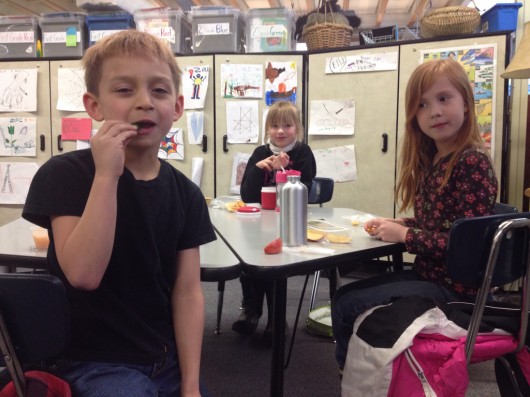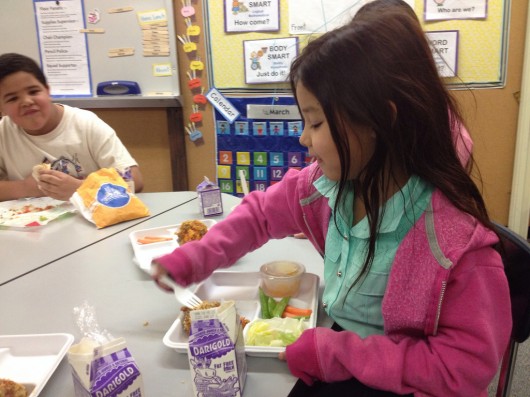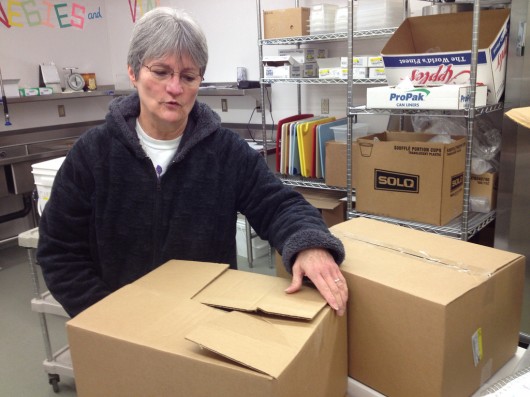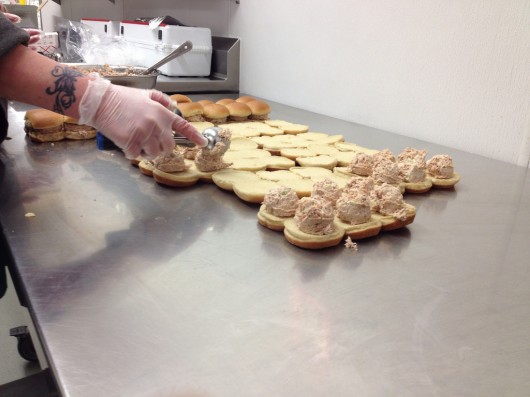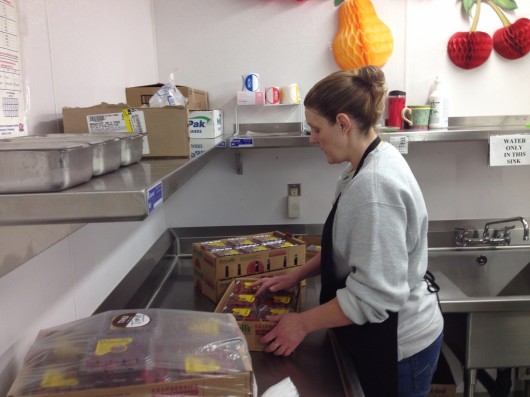In January, Ketchikan parents were invited to their children’s schools to try out the lunch menu.
About 130 parents filled out surveys, and the comments were mixed. Some lamented the sogginess of chicken nuggets or the lack of nutrition in the lettuce. Others praised the salad bar and said the entrees were tasty.
Some of the parents who tried the school lunch said they wondered where the meals are prepared and how that affects the food’s freshness. Here’s a behind-the-scenes look at what goes into Ketchikan school lunches.
Things start early at the Shoenbar Middle School Kitchen. It’s 5 a.m. on a recent Thursday, and a Food Services of America delivery truck is here. The driver unloads boxes of food and brings them into the kitchen.
Madonna Brock is the Food Services Director for Ketchikan schools. She reads a list of what FSA delivers each week.
“Cantaloupe, carrots, cucumber, celery, cheese…”
This food is shipped up on the Alaska Marine Highway from an FSA warehouse in Seattle, Washington. It goes into around 600-650 school lunches made each day here in the Shoenbar kitchen.
Head Cook Jim Lindahl and his assistant, Laurie Morrison, prepare three entrees each day. There’s the main dish, which goes to all the schools, and two alternatives, which go to the high school, Revilla, and Shoenbar in addition to the main dish.
Jim and Laurie are starting out making one of the alternatives: tuna sliders.
Jim and Laurie say they usually sample the dishes they make every day for quality control.
“Oh I think it’s all very nutritious,” Jim said. “It’s just finding what the kids like is the hard part…finding what they’re willing to eat and get the nutrition in there too.”
Madonna sees it similarly. She says the biggest conflict they have to work out is between what kids like and what their parents like.
“Parents don’t really like to see the chicken nuggets on the menu, but that’s when our counts are really high,” she said. “I don’t know what else to do. We’ve been getting more casseroles, and fresh fish twice a month.”
Jim pointed out some of the new, fresher recipes they’ve been trying, including a halibut sandwich and garlic halibut.
The halibut is the only food product that is locally produced. Things like bread, cheese, and bananas come from Food Services of America. The majority of food that make up the entrees – chicken nuggets, hamburgers, pizza, breakfast burrito – that comes pre-made from the federal government. It’s part of the US Department of Agriculture’s National School Lunch Program.
An example of that is today’s main entree for all the schools: enchiladas. Jim and Laurie start making it at about 6 a.m.
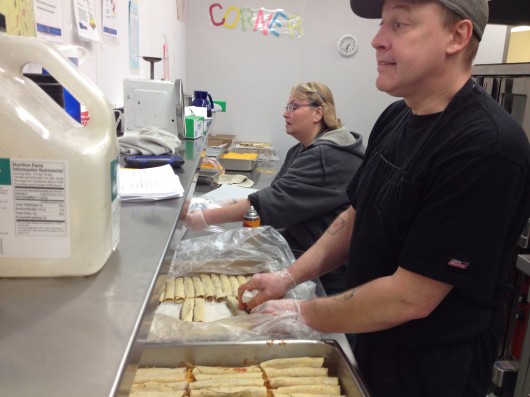
Jim Lindahl and Laurie Morrison prepare enchiladas for lunch. The enchiladas, like most of the school lunch entrees, come from the federal government.
The government foods are shipped to Ketchikan about once a month from Fife, Washington.
“It’s really good product,” Madonna said. “I don’t know when they make it, but its frozen and it’s good.”
Jim and Laurie break apart the frozen tortilla wraps and lay them out in rows in the pan, then they pour enchilada sauce on the tortillas, sprinkle cheese on them, add another layer of frozen enchiladas, and so on. They’ll cook about 20 pans of these for the schools.
On the February lunch menu, out of 19 school days, 15 of the lunches had government product entrees. The other four were either FSA product or Cedar’s Lodge fish. On the March menu, out of 14 school days, 11 had government product entrees.
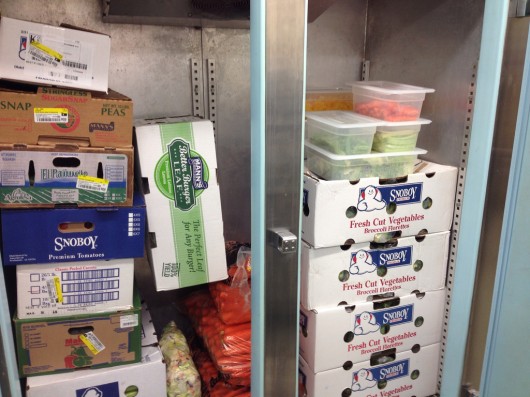
One of the fridges at the Shoenbar Middle School kitchen, where lunch is prepared for almost all of the Ketchikan schools.
The only school Jim and Laurie do not prepare enchiladas for is Point Higgins Elementary, which is about 15 miles north of Shoenbar.
This month they started cooking the lunches on-site at the Point Higgins kitchen.
Mechelle Orin is the one who does that. She says she heads out there around 9 a.m. and prepared lunch for about 100 kids.
Madonna hopes cooking the lunches at Point Higgins will make them taste fresher to the students. She says her goal is to make it possible to cook the lunches on location at each school.
That might help with one of the main complaints on the parents’ survey. A lot of the parents could tell that the food had been sitting in a heater or cooler for a number of hours between when it was made and when it was served.
Throughout the rest of the morning, Jim and Laurie continue with the enchiladas and make the other alternate entrée: chicken fajita salad.
In another section of the kitchen, Nancy Johnson prepares veggies for the salad bar, which is a new addition this school year.
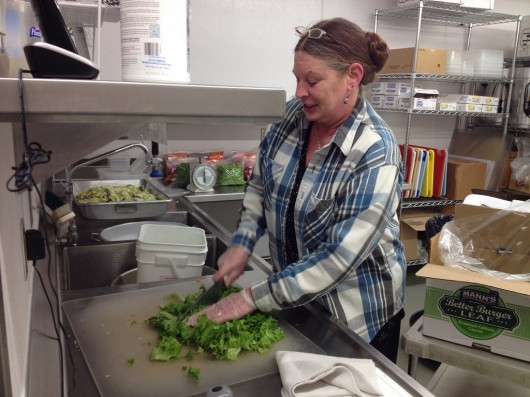
Nancy Johnson chops lettuce for the salad bar, which is a new addition to the school lunches this year.
The parents’ surveys were mixed on the pizza and chicken nuggets, but most were positive about the salad bar.
Another new addition in the schools is the fruit and vegetable program, which is also sponsored by the USDA. Each day, students at Houghtaling, Fawn Mountain, Tongass, and Charter get a snack that is usually a fruit, sometimes a vegetable, ordered from Tatsuda’s, a local grocery store. Today is a special day.
“Today is raspberries,” said Susie McKitrick. “It’s my favorite, it’s their favorite too.”
McKitrick has been working here for two years. She helps serve lunch at Fawn Mountain, and says the kids love their fruit. But she also hears complaints about the lunches.
“I don’t know if we can improve it here, they do a lot, they work really hard, we can only work with what we get,” she said. “I think there’s too much processed food still.”
At around 9 a.m., Glenn Brown, a bus and delivery driver for First Student, arrives.
“There are carts, the hot food is on the top half of the cart, and the bottom is cold for salads, vegetables, etcetera,” he explained.
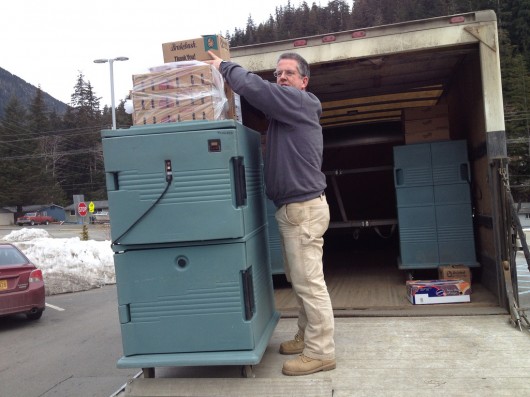
Glenn Brown loads carts filled with lunch onto a delivery truck. One part of the cart holds the hot food, the other hold the cold food.
Glenn rolls three carts full of lunch onto a truck. One each for Tongass, Charter, and Fawn Mountain.
He rolls the first cart into the Charter school around 9:15. And then the second into Tongass school, which is in the same building.
Then, the cart sits there for a while. Plugged into an outlet in the wall, keeping the enchiladas hot and the salad and veggies cold.
After a few more hours, at 1 p.m., it’s lunch time at Tongass.
The first and second graders give today’s lunch good reviews. Some don’t know exactly what the enchiladas are, but they seem to enjoy them.

